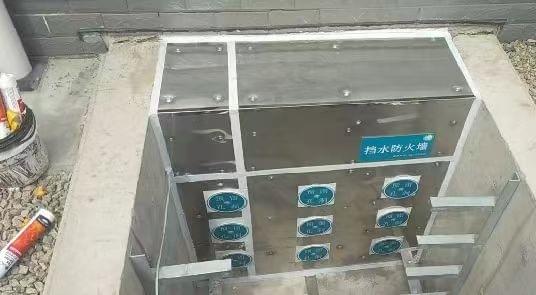Problem: Dual Risks from Hidden Openings
In industrial and infrastructure buildings, cable trenches and pipe penetrations through exterior walls are often overlooked as critical safety vulnerabilities.
- Flood Risk: Rainwater and urban flooding seep in through openings, submerging control rooms and power distribution rooms, leading to electrical short circuits and equipment damage.
- Fire Risk: Flames and smoke spread rapidly through unsealed penetrations, compromising fire compartments and amplifying the impact of disasters.
Even a small opening can determine the safety of an entire building.

Standard: Explicit Requirements of FM 1-40
FM Global Data Sheet 1-40 Flood specifies in §2.2.6.2.2:
All potential water entry points in floors and walls must be sealed, including:
- Sanitary piping: Automatic shutoff devices should be used, such as backflow valves on wastewater pipes.
- Sewer and floor drains: Backwater prevention valves are recommended; manual devices are only supplemental.
- Pipe penetrations: Gaps must be permanently sealed with waterproof materials.
- Ventilation ducts and shafts: Should be rerouted above the Design Flood Elevation (DFE), and residual openings must be sealed.
- Power and communication conduits: Including panelboard wiring holes, all must be permanently sealed.
- Construction joints and cracks: Must be sealed and repaired to prevent water intrusion.
Solution: Weiwang’s Integrated Sealing System
Shanghai Weiwang Technology Co., Ltd., in accordance with FM 1-40 §2.2.6.2.2 requirements and international fire protection codes, has developed an integrated flood and fire barrier system for cable and pipe penetrations.
Key Advantages:
- Dual Protection: A single system provides both flood and fire protection, meeting watertightness, airtightness, and fire-resistance requirements.
- Modular Adaptation: Fits different diameters and quantities of cables and pipes, supporting future expansion and maintenance.
- High Reliability: Built with stainless steel frames and high-performance sealing components; UV-resistant, corrosion-resistant, and tested for both watertightness and fire resistance.
- Standards Compliance: Fully aligned with FM 1-40 requirements, and also complies with UL, GB, and other international codes.

Applications: Critical Scenarios Across Industries
- Cable trenches and wall penetrations – Prevent simultaneous intrusion of floodwater and fire into control rooms.
- Underground facilities and metro projects – Protect weak points where large numbers of cables and pipes converge.
- Petrochemical and energy plants – Provide redundant safety design in high-risk environments.
- Data centers and communication rooms – Ensure uninterrupted operation of electrical and information systems.
Conclusion
Cable and pipe penetrations are the first line of vulnerability in building flood and fireprotection.
Relying on the requirements of FM 1-40, Shanghai Weiwang Technology Co., Ltd. has launched its integrated flood and fire sealing system, transforming standards into practical engineering solutions. This system establishes a robust safety shield for data centers,
factories, metro infrastructure, and energy facilities, ensuring the continuous and secure operation of buildings.

